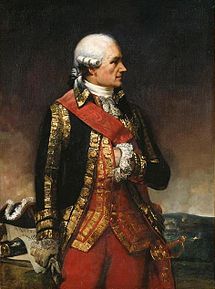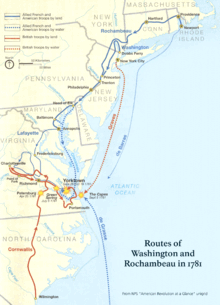- Jean-Baptiste Donatien de Vimeur, comte de Rochambeau
-
Jean-Baptiste Donatien de Vimeur de Rochambeau 
Born 1 July 1725
Vendôme, Loir-et-Cher, FranceDied 10 May 1807 (aged 81)
Thoré-la-Rochette, FranceAllegiance  Royaume de France
Royaume de FranceRank Marshal of France Marshal of France Jean-Baptiste Donatien de Vimeur, comte de Rochambeau (French pronunciation: [ʁɔʃɑ̃bo]; 1 July 1725 – 10 May 1807) was a French nobleman and general who participated in the American Revolutionary War as the commander-in-chief of the French Expeditionary Force which came to help the American Continental Army. During the French Revolution, he commanded the Armée du Nord, but was arrested during the Reign of Terror and narrowly escaped the guillotine.
Contents
Military life
Rochambeau was born in Vendôme, Loir-et-Cher. He was schooled at the Jesuit college in Blois. However, after the death of his elder brother, he entered a cavalry regiment, and served in Bohemia, Bavaria, and on the Rhine, during the War of the Austrian Succession. In 1747 he had attained the rank of colonel.
He took part in the siege of Maastricht in 1748 and became governor of Vendôme in 1749. After distinguishing himself in 1756 in the Battle of Minorca on the outbreak of the Seven Years' War, he was promoted to Brigadier General of infantry. In 1758, he fought in Germany, notably in the battles of Krefeld and Clostercamp, receiving several wounds during the latter.
 Landing of a French auxiliary army in Newport, Rhode Island on 11 July 1780, under the command of the comte de Rochambeau. This image, one of 12 scenes from the American Revolution printed in Allegemeines historisches Taschenbuch, was by Daniel Nickolaus Chodowiecki, a well-known Polish engraver. The John Carter Brown Library at Brown University had acquired the book by 1870.
Landing of a French auxiliary army in Newport, Rhode Island on 11 July 1780, under the command of the comte de Rochambeau. This image, one of 12 scenes from the American Revolution printed in Allegemeines historisches Taschenbuch, was by Daniel Nickolaus Chodowiecki, a well-known Polish engraver. The John Carter Brown Library at Brown University had acquired the book by 1870.
American Revolution
Main article: Franco-American alliance NPS map of the W3R Route
NPS map of the W3R Route
 Bataille de Yorktown by Auguste Couder. Rochambeau and Washington giving their last orders before the battle.
Bataille de Yorktown by Auguste Couder. Rochambeau and Washington giving their last orders before the battle.
 Surrender of Cornwallis at Yorktown by John Trumbull, depicting Cornwallis surrendering to the French troops of Rochambeau (left) and American troops of Washington (right). Oil on canvas, 1820.
Surrender of Cornwallis at Yorktown by John Trumbull, depicting Cornwallis surrendering to the French troops of Rochambeau (left) and American troops of Washington (right). Oil on canvas, 1820.
In 1780, Rochambeau was appointed commander of land forces as part of the project code named Expédition Particulière.[1] He was given the rank of Lieutenant General in command of some 7,000 French troops and sent to join the Continental Army, under George Washington in the American Revolutionary War Rochambeau commanded more troops than did Washington. Count Axel von Fersen the Younger served as Rochambeau's aide-de-camp and interpreter. The small size of the force at his disposal made him initially reluctant to lead the expedition.[2]
He landed at Newport, Rhode Island, on 10 July, but was held there inactive for a year, owing to his reluctance to abandon the French fleet blockaded by the British in Narragansett Bay. Brown University, then named the College in the Colony of Rhode Island and Providence Plantations, served as an encampment site for some of Rochambeau's troops, and the College Edifice, now known as University Hall, was converted into a military hospital.[3] In July 1781, Rochambeau's force left Rhode Island, marching across Connecticut to join Washington on the Hudson River at Dobbs Ferry, New York. From July 6 to August 18, 1781, the Odell farm served as Rochambeau's headquarters.[4] There then followed the celebrated march of the combined forces, the siege of Yorktown and the Battle of the Chesapeake. On 22 September, they combined with Marquis de Lafayette's troops and forced Lord Cornwallis to surrender on 19 October. In recognition of his services, the Congress of the Confederation presented him with two cannons taken from the British. These guns, with which Rochambeau returned to Vendôme, were requisitioned in 1792.
He was an original member of The Society of the Cincinnati.
Return to France
Upon his return to France, he was honored by King Louis XVI and was made governor of Picardy, a historical province in the north of France.
During the French Revolution, he commanded the Armée du Nord (the military of France) during the period between the fall of the Ancien Régime under Louis XVI in 1792 and the formation of the First French Empire under Napoleon Bonaparte in 1804, and created Marshal of France on 28 December 1791, but resigned in 1792 after several reverses. Despite being sympathetic to the National Assembly, Rochambeau was arrested during the Reign of Terror, a period of violence that occurred after the onset of the French Revolution, and narrowly escaped the guillotine. He was subsequently pensioned by Napoleon Bonaparte and died at Thoré-la-Rochette during the First French Empire.[5]
Legacy
French Armed Forces Components French Air Force French Army French Navy Gendarmerie Ranks Ranks in the French Army Ranks in the French Navy History of the French Military Military History of France La Grande Armée Honors
A statue of Rochambeau by Ferdinand Hamar was unveiled in Lafayette Square in Washington, D.C., by President Theodore Roosevelt on 24 May 1902, as a gift from France to the United States. The ceremony was made the occasion of a great demonstration of friendship between the two nations. France was represented by ambassador Jules Cambon, Admiral Fournier and General Henri Brugère, as well as a detachment of sailors and marines from the battleship Gaulois. Representatives of the Lafayette and Rochambeau families also attended. A Rochambeau fête was held simultaneously in Paris.
In 1934, American A. Kingsley Macomber donated a statue of General Rochambeau to the city of Newport, Rhode Island. The sculpture is a replica of a statue in Paris. It was from Newport that General Rochambeau departed with his army to join General Washington to march on to the Siege of Yorktown. [2]
The French Navy gave his name to the ironclad frigate Rochambeau.
The USS Rochambeau was a transport ship that saw service in the United States Navy during World War II.
On Monday, 30 March 2009, U.S. President Barack Obama signed into law the Omnibus Public Land Management Act, one of whose provisions is to designate the Washington-Rochambeau Revolutionary Route as a National Historic Trail.
Memoirs
Rochambeau's memoirs, Mémoires militaires, historiques et politiques, de Rochambeau were published by Jean-Charles-Julien Luce de Lancival in 1809. Of the first volume, a part that was translated by M.W.E. Wright into the English Language was published in 1838 under the title of Memoirs of the Marshal Count de R. relative to the War of Independence in the United States.
Rochambeau's correspondences during the American campaign were published in H. Doniol's Histoire de la participation de la France en l'établissement des Etats Unis d'Amérique, or History of French Participation in the Establishment of the United States, in 1892; (MLA citation, Doniol, H. Histoire de la participation de la France en l'établissement des Etats Unis d'Amérique, Vol. V. [publisher unknown] Paris: 1892.)
Miscellany
 Major General Comte Jean de Rochambeau in Lafayette Park, Washington, D.C.
Major General Comte Jean de Rochambeau in Lafayette Park, Washington, D.C.
 US Postage Stamp, 1931 issue, honoring Rochambeau, George Washington and De Grasse, commemorating 150th anniversary of the victory at Yorktown, 1781.
US Postage Stamp, 1931 issue, honoring Rochambeau, George Washington and De Grasse, commemorating 150th anniversary of the victory at Yorktown, 1781.
- Rochambeau's son, Donatien-Marie-Joseph de Vimeur was an important figure in the Haitian Revolution.
- Rochambeau Middle School in Southbury, Connecticut is named for the comte de Rochambeau, as is the Rochambeau Bridge which carries Interstate 84 and U.S. Highway 6 between Southbury and Newtown, Connecticut (Rochambeau's army marched through the area during the American Revolutionary War). There are also various shopping centers and minor streets named in Rochambeau's honor throughout Connecticut.
- The French international school (lycée français) in Bethesda, Maryland is named Lycée Rochambeau.
- A bridge over the Potomac River in Washington, D.C., is also named for Rochambeau.
- There is a Rochambeau Drive named in his honor in Greenburgh, New York and in Williamsburg, Virginia, which is not far from the Yorktown battlefield.
- There is a Rochambeau Avenue named in his honor in Providence, Rhode Island, as well as a Rochambeau Street in both New Bedford, Massachusetts and Dobbs Ferry, New York.
- There is a Rochambeau Avenue named in his honor in the Bronx, New York.
- There is a Rochambeau Place in Springfield, Virginia.
- There is a statue of Rochambeau in Newport, Rhode Island and another in Washington, D.C. on Pennsylvania Avenue across from the White House in Lafayette Park that, according to the United States Park Service was sculpted by Fernand Hamar and cast by the Pal d'Osne foundry in France and dedicated 24 May 1904, and a statue memorializing his meeting with George Washington in Dobbs Ferry, New York.
- There is a Rochambeau Playground in the Richmond District in San Francisco, California.[6]
- There is a "Rochambeau Farm" on the Historic Guard Hill in Bedford Corners, New York.
- There is a Rochambeau monument at French Hill in Marion, Connecticut close to the Asa Barnes Tavern, the eighth campsite of his troops through Connecticut in 1781.
Notes
- ^ Kennett, Lee (1977). The French Forces in America, 1780-1783. Greenwood Press, Inc. Page 10
- ^
 "Jean-Baptiste-Donatien de Vimeur, Count de Rochambeau". Catholic Encyclopedia. New York: Robert Appleton Company. 1913.
"Jean-Baptiste-Donatien de Vimeur, Count de Rochambeau". Catholic Encyclopedia. New York: Robert Appleton Company. 1913. - ^ [1]
- ^ Lenore M. Rennenkampf (February 1973). "National Register of Historic Places Registration:Odell House". New York State Office of Parks, Recreation and Historic Preservation. http://www.oprhp.state.ny.us/hpimaging/hp_view.asp?GroupView=10430. Retrieved 2010-12-24.
- ^ Jean-Baptiste-Donatien Count de Rochambeau at Find a Grave
- ^ Rochambeau Playground
References
 This article incorporates text from a publication now in the public domain: Chisholm, Hugh, ed (1911). Encyclopædia Britannica (11th ed.). Cambridge University Press. In turn, it cites as references:
This article incorporates text from a publication now in the public domain: Chisholm, Hugh, ed (1911). Encyclopædia Britannica (11th ed.). Cambridge University Press. In turn, it cites as references:
- Arthur Du Chêne, "Autour de Rochambeau" in Revue des facultés catholiques de l'ouest (1898–1900)
- E. Gachot, "Rochambeau" in Nouvelle Revue (1902)
- H. de Ganniers, "La Dernière Campagne du maréchal de Rochambeau" in Revue des questions historiques (1901)
External links
Categories:- 1725 births
- 1807 deaths
- People from Vendôme
- Counts of Rochambeau
- Marshals of France
- Governors of Saint-Domingue
- Military leaders of the French Revolutionary Wars
- French military personnel of the American Revolutionary War
- American Revolutionary War
- 1781 in the United States
- 1781 in France
- History of Connecticut
- Rhode Island in the American Revolution
- Virginia in the American Revolution
- York County, Virginia
- Newport, Rhode Island
- Recipients of the Order of the Holy Spirit
- Members of the Society of the Cincinnati
Wikimedia Foundation. 2010.


